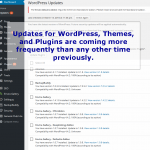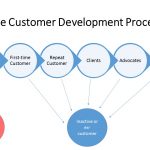My Experience with Redesigning my Current Website.
My effort continues as an ongoing work-in-progress, as with all content refresh efforts – it remains a job without end.

As a result of my redesign efforts, I have learned few things I would like share with you. These website redesign insights are valuable to readers that are first-time re-designers. The end-goal is to produce a website that’s appealing to human visitors and secondly rewritten to improve search engine optimization, SEO. SEO Find-ability is an important issue, but it’s more important to write for your target audience to satisfy their need of content consumption. Content that is easy to read and of interest to your community will be shared.
The most enlightening advice I can give you is “Starting with the Finish Redesign in Mind”. This means you must define the purpose of your website redesign and thoroughly plan out the details of the implementation for each piece that will be modified, replaced and new content objects to be inserted at particular locations.
My first priority is to appeal to the human visitors by creating a visual attractive display of content objects that flow. These objects are a collection of graphics, images, headers or just plain text. The collection of objects must work together to be satisfying and instantly understood. The flow must be easy to follow. The resulting composition must be devoid of confusion. It’s easy to be caught in a dilemma of trying different things while you’re reworking your canvas with results you don’t like. You end up with an art-form – that needs more work.
Secondly, written content or copy must be an integral part of the visual delivery. The intellectual message must fit visually, emotionally and connect to the audience. When you start a new redesign you may not have a vision or any firm idea about how to accomplish this. It requires inspiration and rework, rework and more rework until you arrive at art-form you are seeking. The difference between design and redesign, is redesign you carry a lot more old baggage from the original design with the underlying goal to reuse content objects and improve the collection of objects.
In any major redesign, the focus is to change the physical look and feel of the website to make it different and attractive to visitors, so they will want to do the following:
- Read the new content and newly revised copy
- Use new features to easily go to the information being sought
- Provide feedback
- Perform an action
The redesign changes should be devised and developed to align with your redesign purpose and business goals by hitting the bulls-eye mark in delivering what the customers need and wants from visiting your website to invoke individual calls-to-action.
The redesign process shouldn’t be done blindly, but based on the specific knowledge of your marketing segments, your experiences with the audience you want to reach and new ideas to increase visitor traffic. Google Analytics can be very useful in determining the pages that need attention to changes.
I started my redesign by separating old website content objects into 3 buckets: No-changes, Changes and Deletes. The content objects consisted of: colors, fonts, icons, information structure, menus, functional features, website pages,website theme, plug-ins, page layouts, images, forms, graphics, copy and headers. The changes I am referring to involve the rework or replacement of current content objects, inclusion of new content objects, copywriter revisions and the creation of better and more relevant headlines and copy. The revamping of on-site SEO is integrated part of this website redesign and a significant task that must be performed for each website page before the redesign is deemed complete.
Through this endeavor, I have developed new best-practices that I can use to help my clients improve their web presence and Internet visibility. The following are key points learned from my redesign efforts that I want share with you:
- Always perform the redesign on a different domain than the original domain in parallel with the old website
- Redesign on the same site will be difficult and will reduce the SEO strength of the finish website
- Redesign involves duplicate content that must be hidden from the search engines until the redesign is completed
- Even with a plan that addresses each content object, the final design will be a tweaked version different from the plan
- When implementing the changes, each content object must contribute to a story or theme or overarching concept
- Continually question whether the redesign website is remarkable, worth noticing and if it commands attention
- Capture the keywords for each page that describes the essence of what the page is expressing
- Rework each page so all the content objects are aligned to express the same concept
- Tweak each page over a period of time to become remarkable
- Analyze and modify each webpage to fulfill the purpose of the page and ensure execution of the call-to-action
- Evaluate and improve on-site SEO with the Yoast WP SEO Plug-in and maximize on-site SEO
- Define and redirect a cross-reference of old URL’s to new URL’s using 301 redirect statements in the .htaccess file
- Cut-over the redesigned website by removing the password lock and pointing the original domain’s name servers to the redesigned site





Leave a Reply